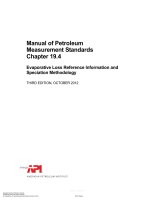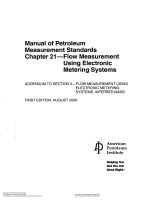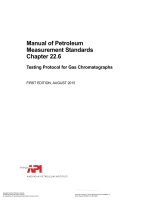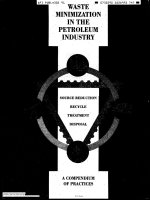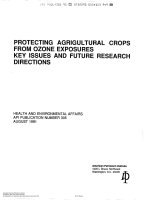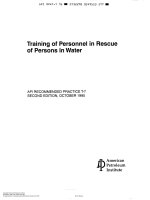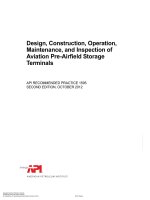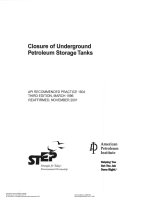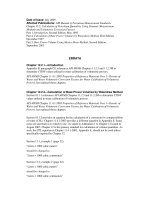Api mpms 6 6 1991 (2012) (american petroleum institute)
Bạn đang xem bản rút gọn của tài liệu. Xem và tải ngay bản đầy đủ của tài liệu tại đây (894.31 KB, 16 trang )
Manual of Petroleum
Measurement Standards
Chapter 6—Metering Assemblies
Section 6—Pipeline Metering Systems
SECOND EDITION, MAY 1991
REAFFIRMED, JANUARY 2012
--`,,```,,,,````-`-`,,`,,`,`,,`---
Copyright American Petroleum Institute
Provided by IHS under license with API
No reproduction or networking permitted without license from IHS
Not for Resale
--`,,```,,,,````-`-`,,`,,`,`,,`---
Copyright American Petroleum Institute
Provided by IHS under license with API
No reproduction or networking permitted without license from IHS
Not for Resale
Manual of Petroleum
Measurement Standards
Chapter 6—Metering Assemblies
Section 6—Pipeline Metering Systems
Measurement Coordination
SECOND EDITION, MAY 1991
REAFFIRMED, JANUARY 2012
--`,,```,,,,````-`-`,,`,,`,`,,`---
Copyright American Petroleum Institute
Provided by IHS under license with API
No reproduction or networking permitted without license from IHS
Not for Resale
SPECIAL NOTES
1. API PUBLICATIONS NECESSARILY ADDRESS PROBLEMS OF A GENERAL
NATURE. WITH RESPECT TO PARTICULAR CIRCUMSTANCES, LOCAL, STATE,
AND FEDERAL LAWS AND REGULATIONS SHOULD BE REVIEWED.
2. API IS NOT UNDERTAKING TO MEET THE DUTIES OF EMPLOYERS,
MANUFACTURERS, OR SUPPLIERS TO WARN AND PROPERLY TRAIN AND
EQUIP THEIR EMPLOYEES, AND OTHERS EXPOSED, CONCERNING HEALTH
AND SAFETY RISKS AND PRECAUTIONS NOR UNDERTAKING THEIR OBLIGATIONS UNDER LOCAL, STATE, OR FEDERAL LAWS.
3. INFORMATION CONCERNING SAFETY AND HEALTH RISKS AND PROPER
PRECAUTIONS WITH RESPECT TO PARTICULAR MATERIALS AND CONDITIONS SHOULD BE OBTAINED FROM THE EMPLOYER, THE MANUFACTURER
OR SUPPLIER OF THAT MATERIAL, OR THE MATERIAL SAFETY DATA SHEET.
4. NOTHING CONTAINED IN ANY API PUBLICATION IS TO BE CONSTRUED AS
GRANTING ANY RIGHT, BY IMPLICATION OR OTHERWISE, FOR THE
MANUFACTURE, SALE, OR USE OF ANY METHOD, APPARATUS, OR PRODUCT
COVERED BY LETTERS PATENT. NEITHER SHOULD ANYTHING CONTAINED
IN THE PUBLICATION BE CONSTRUED AS INSURING ANYONE AGAINST
LIABILITY FOR INFRINGEMENT OF LETTERS PATENT.
5. GENERALLY, API STANDARDS ARE REVIEWED AND REVISED, REAFFIRMED, OR WITHDRAWN AT LEAST EVERY FIVE YEARS. SOMETIMES A
ONE-TIME EXTENSION OF UP TO TWO YEARS WILL BE ADDED TO THIS
REVIEW CYCLE. THIS PUBLICATION WILL NO LONGER BE IN EFFECT AS AN
OPERATIVE API STANDARD FIVE YEARS AFTER ITS PUBLICATION DATE OR,
WHERE AN EXTENSION HAS BEEN GRANTED, UPON REPUBLICATION. THE
STATUS OF THE PUBLICATION CAN BE ASCERTAINED FROM THE API
AUTHORING DEPARTMENT (TELEPHONE 202 682-8000). A CATALOG OF API
PUBLICATIONS AND MATERIALS IS PUBLISHED ANNUALLY AND UPDATED
QUARTERLY BY API, 1220 L STREET, N.W., WASHINGTON, D.C. 20005.
Copyright@ 1991 American Petroleum Institute
--`,,```,,,,````-`-`,,`,,`,`,,`---
Copyright American Petroleum Institute
Provided by IHS under license with API
No reproduction or networking permitted without license from IHS
Not for Resale
FOREWORD
This publication provides guidelines for selecting the types and sizes of meters for use
on pipelines.
API publications may be used by anyone desiring to do so. Every effort has been made
by the Institute to assure the accuracy and reliability of the data contained in them; however,
the Institute makes no representation, warranty, or guarantee in connection with this
publication and hereby expressly disclaims any liability or responsibility for loss or damage
resulting from its use or for the violation of any federal, state, or municipal regulation with
which this publication may conflict.
Suggested revisions are invited and should be submitted to the director of the Measurement Coordination Department, American Petroleum Institute, 1220 L Street, N.W.,
Washington, D.C. 20005.
--`,,```,,,,````-`-`,,`,,`,`,,`---
Copyright American Petroleum Institute
Provided by IHS under license with API
No reproduction or networking permitted without license from IHS
iii
Not for Resale
CONTENTS
Page
SECTION &PIPELINE METERING SYSTEMS
--`,,```,,,,````-`-`,,`,,`,`,,`---
6.6.1 Introduction . . . . . . . . . . . . . . . . . . . . . . . . . . . . . . . . . . . . . . . . . . . . . . . . . . . . .
6.6.2 Scope . . . . . . . . . . . . . . . . . . . . . . . . . . . . . . . . . . . . . . . . . . . . . . . . . . . . . . . . . .
6.6.3 Field of Application . . . . . . . . . . . . . . . . . . . . . . . . . . . . . . . . . . . . . . . . . . . . . .
6.6.4 Referenced Publications . . . . . . . . . . . . . . . . . . . . . . . . . . . . . . . . . . . . . . . . . . .
6.6.5 Meter Station Design . . . . . . . . . . . . . . . . . . . . . . . . . . . . . . . . . . . . . . . . . . . . . .
6.6.5.1 Meter Selection ..............................................
6.6.5.1.1 Viscosity . . . . . . . . . . . . . . . . . . . . . . . . . . . . . . . . . . . . . . . . . . . . . .
6.6.5.1.2 Density . . . . . . . . . . . . . . . . . . . . . . . . . . . . . . . . . . . . . . . . . . . . . . .
6.6.5.1.3 Corrosive, Abrasive, and Foreign Materials . . . . . . . . . . . . . . . . . . .
6.6.5.1.4 Vapor Pressure .........................................
6.6.5.1.5 FlowRate . . . . . . . . . . . . . . . . . . . . . . . . . . . . . . . . . . . . . . . . . . . . .
6.6.5.1.6 Temperature . . . . . . . . . . . . . . . . . . . . . . . . . . . . . . . . . . . . . . . . . . .
6.6.5.1.7 Continuous or Intermittent Service ..........................
6.6.5.1.8 Location . . . . . . . . . . . . . . . . . . . . . . . . . . . . . . . . . . . . . . . . . . . . . . .
6.6.5.2 Metersizing . . . . . . . . . . . . . . . . . . . . . . . . . . . . . . . . . . . . . . . . . . . . . . . .
6.6.5.2.1 General Considerations ...................................
6.6.5.2.2 Sizing Displacement Meters ...............................
6.6.5.2.3 Sizing Turbine Meters ....................................
6.6.5.3 Instrumentation and Accessories ................................
6.6.5.3.1 Strainers and Filters .....................................
6.6.5.3.2 Water Separators and Water Monitors .......................
6.6.5.3.3 Back-Pressure Valves ....................................
6.6.5.3.4 Flow Control Valves .....................................
6.6.5.3.5 AirRemovers ..........................................
6.6.5.3.6 Flow Conditioning ......................................
6.6.5.3.7 Displacement Meter Counters .............................
6.6.5.3.8 Turbine Meter Counters ..................................
6.6.5.3.9 Ticket Printers ..........................................
6.6.5.4 Sampling ...................................................
6.6.5.5 Proving ....................................................
6.6.5.5.1 Tankprovers . . . . . . . . . . . . . . . . . . . . . . . . . . . . . . . . . . . . . . . . . . .
6.6.5.5.2 Conventional Pipe Provers ................................
6.6.5.5.3 Small-Volume Provers ...................................
6.6.5.5.4 Master-Meter Provers ....................................
6.6.5.6 Typical Pipeline-Meter Station Layouts ...........................
6.6.6 Meter Station Operation ...........................................
6.6.7 Meter Performance ...............................................
6.6.7.1 Net Standard Volumes ........................................
6.6.7.2 Meterproving ...............................................
6.6.7.3 Meter Factor Control Charts ....................................
1
1
1
1
1
1
2
2
2
2
2
2
3
3
3 .
3
3
3
4
4
4
4
4
4
5
5
5
5
5
5
6
6
6
6
6
6
6
6
9
9
Figures
1-Typical Schematic Arrangement of Pipeline-Meter Station
With Three Displacement Meters .....................................
2-Typical Schematic Arrangement of Pipeline-Meter Station
With Two Turbine Meters ..........................................
7
V
Copyright American Petroleum Institute
Provided by IHS under license with API
No reproduction or networking permitted without license from IHS
Not for Resale
8
Chapter 6-Metering Assemblies
SECTION 6-PIPELINE
METERING SYSTEMS
6.6.1 Introduction
API
Manual of Petroleum Measurement Standards
Chapter K‘Proving Systems”
Chapter 4.3, ‘‘Small-Volume Provers”
Chapter 5-“Metering”
Chapter 5.1, “General Considerations for
Measurement by Meters”
Chapter 5.2, “Measurement of Liquid
Hydrocarbons by Displacement Meter”
Chapter 5.3, “Measurement of Liquid
Hydrocarbons by Turbine Meters”
Chapter 5.4, “Accessory Equipment for Liquid Meters”
Chapter 5.5, “Fidelity and Security of Flow
Measurement Pulsed-Data Transmission
Systems”
Chapter 8-“Sampling”
Chapter 12.2, “Calculation of Liquid
Petroleum Quantities Measured by Turbine
or Displacement Meters”
Chapter 13.2, “Statistical Evaluation of
Meter Proving Data” (under development)
The three principal characteristics of a pipeline that affect
the selection of the type of measurement equipment best
suited to it are:
a. The high fixed cost, which makes continuous operation
desirable.
b. The capacity, which implies large volumes and high rates.
c. The need for efficient operation and maximum accuracy
in measuring the throughput of the system.
The advantages of dynamic measurement (metering) over
static measurement (gauging) for pipeline oil movements are
provided in Chapter 5.1.
This chapter deals with liquid hydrocarbons (crude oils,
condensates, refined products, and hydrocarbon mixtures).
Two-phase fluids are not included.
Individuals concerned with installing measurement equipment for liquid hydrocarbons of high vapor pressures, such
as ethane-propane mixes, propylenes, and so on, may find this
chapter useful; however, special additional precautions may
be required.
6.6.2 Scope
6.6.5 Meter Station Design
--`,,```,,,,````-`-`,,`,,`,`,,`---
This chapter provides guidelines for selecting the type and
size of meter(s) to be used to measure pipeline movements.
Types of accessories and instruments that may be desirable
are specified, and the relative advantages and disadvantages
of the methods of proving meters by tank prover, by conventional pipe prover, by small volume prover, and by master
meter are discussed. This chapter also includes discussions
on obtaining the best operating results from a pipeline-meter
station.
As defined in this publication, a metering station on a
pipeline system is one where custody transfer measurement
takes place through one or more meters. When a pipelinemetering system is designed, the objective is to obtain optimum measurement accuracy for custody transfers
regardless of the volume handled. The measurement accuracy
of the system depends on meters, provers, valves, and other
equipment selected for that measurement system.
Other considerations for a meter station design include
providing for future expansion and upgrades, accessibility of
the equipment for maintenance, and accuracy verification.
Chapters 4 and 5 of this manual should be consulted for
further requirements common to all proving and metering
systems.
6.6.3 Field of Application
The information provided in this chapter may be applied
to the following systems:
a. Gathering systems from production facilities to a main
crude oil storage or pipeline system.
b. Crude oil pipelines.
c. Refined product pipelines.
d. Liquefied petroleum gas (LPG) pipelines.
6.6.5.1
Although displacement meters (see Chapter 5.2) and turbine meters (see Chapter 5.3) are the most commonly used
meters in pipeline applications, other types of meters are not
excluded if they serve the intended purpose.
Meter selection is discussed in Chapter 5.1. In general,
turbine meters are preferred for high-flow rate and lowviscosity applications. In high-pressure applications, capital
6.6.4 Referenced Publications
Many of the aspects of the metering functions are considered at length in other parts of this manual. Please refer to
the following chapters for more information.
1
Copyright American Petroleum Institute
Provided by IHS under license with API
No reproduction or networking permitted without license from IHS
METER SELECTION
Not for Resale
2
CHAPTER 6-METERING
and installation costs ofturbine meters may be less. However,
in crude oil service viscosity, wax content or the presence of
fibrous material may limit the use of turbine meters. When
the relative merits of displacement and turbine meters are
evaluated, both maintenance and operating costs should be
considered. Maintenance costs for displacement meters may
be significant when liquids with poor lubricity or abrasive
characteristics are handled. Turbine meter maintenance costs
are usually low, but maintenance of adequate back-pressure
to ensure accuracy may result in higher power costs.
Before selecting a meter, the designer must know or have
a good estimate of the following:
a. The range of physical and chemical characteristics of the
liquid in:
1. Viscosity, lubricity, and pour-point.
2. Density (API gravity).
3. Corrosive, abrasive, fibrous, wax, or other foreign
material.
4. Vapor pressure.
b. The range of flow rates and pressures.
c. The range of liquid temperature and ambient temperatures
that will be encountered.
d. The duration of operation (continuous or intermittent).
e. The location of the meter station and whether its control
is to be local or remote, attended or unattended.
6.6.5.1.1
Viscosity
The-linearity of a displacement meter improves as the
viscosity of the fluid being metered increases. This improvement is a result of decreased slippage in the meter. (See
Chapter 5.2.)
Turbine meters generally perform with a broader linear
range in lower viscosities. (See Chapter 5.3.)
Turbine meters would normally be selected for use with
low-viscosity refined products, such as propane, gasoline,
diesel oil, and so on, because of their longer service life,
greater rangeability, and equal or better accuracy than a
displacement meter on these types of products. (See Chapter
5.1.)
6.6.5.1.2 Density
The rating of a displacement meter is generally not affected by the density of the liquid that it must measure. In
installations where turbine meters are used, the linear range
of the meter tends to shift with density. (See Chapter 5.3.) In
general, a turbine meter’s normal flow range shifts to a higher
range as density decreases. Conversely, for higher density
liquids, the pressure drop across the meter increases more
rapidly as flow rate increases.
6.6.5.1.3
Corrosive, Abrasive, and Foreign
Materials
Abrasive solids, acid or alkaline chemicals, and some salts
are typical foreign materials in a petroleum liquid that can
harm a meter and its operation. If displacement meters are
intended for use with liquids containing relatively large
amounts of abrasive or corrosive materials, the manufacturer
should be consulted about the materials used for meter
construction.
In general, a limited amount of fine abrasives and corrosive contaminants have less effect on the life and performance of a turbine meter because solids in suspension
continue to flow uninterrupted through the meter. Corrosive
contaminants do not affect, to any marked degree, typical
stainless steel turbine meters. On the other hand, displacement meters are more affected by fine abrasives because of
the close clearances of the moving parts and because the
standard materials of construction can be affected by reactive
chemicals. Conversely, fibrous materials, weeds, and wax,
which are sometimes present in crude oils, have little effect
on displacement meters. However, these contaminants tend
to become lodged on rotor blades and straightening sections
of turbine meters and affect their operation.
6.6.5.1.4
Vapor Pressure
The vapor pressure of the liquid to be metered is a factor
in determining the pressure rating required for the meter and
the meter manifold. Vapor pressure also has a bearing on the
type of pressure control equipment and valves needed to
maintain a liquid phase and accurate measurement.
6.6.5.1.5
Flow Rate
The selected meters shall have the capacity to handle the
minimum and maximum expected pipeline flow rate. Displacement meters are normally selected for continuous operation at about 75 percent of the manufacturer’s nameplate
capacity, if the liquid has reasonable lubricity. The capacity
of displacement meters is reduced to as low as 40 percent of
nameplate capacity for liquids with poor lubricity, such as
butane or propane. Turbine meters may be operated at full
nameplate capacity and beyond, but because pressure drop
increases with flow rate, power costs may be a factor in
choosing the most suitable size of meter.
Optimum accuracy may require displacement meters to be
operated at rates above 20 percent of maximum nameplate
capacity. Turbine meters, depending on fluid characteristics,
may require operation at rates above 40 percent of maximum
nameplate capacity for optimum accuracy.
6.6.5.1.6 Temperature
--`,,```,,,,````-`-`,,`,,`,`,,`---
Copyright American Petroleum Institute
Provided by IHS under license with API
No reproduction or networking permitted without license from IHS
ASSEMBLIES
Not for Resale
When pipelines generally operate in moderate ambienl
SECTION
&PIPELINE METERING
SYSTEMS
rate if the primary meter fails.
c. Size each displacement meter for normal operation at 75
percent of its maximum nameplate capacity.
In most cases when a tank prover is to be used, a minimum
of two meters in parallel will be required because flow from
the meter to be proved has to be stopped immediately before
and after proving. It may not be practical to interrupt the
pipeline flow to achieve this requirement except in cases of
small lease automatic custody transfer (LACT) gathering
systems.
Final selection depends on the performance desired, the
space available, and the size and cost (capital and operating)
of the meters, prover, associated valves, piping, and auxiliary
equipment.
6.6.5.2.3
Sizing Turbine Meters
6.6.5.1.7 Continuous or Intermittent Service
Both displacement and turbine meters are designed for
either continuous or intermittent service. However, for continuous operation, some arrangement must be provided for
standby metering or alternate methods of measurement to
cope with normal meter maintenance, scraper runs, or equipment trouble. (See 6.6.5.2.)
6.6.5.1.8
Location
Displacement meters with mechanical registers are well
suited to small capacity systems and remote locations. They
do not necessarily require uninterrupted electric power and
electronic equipment to provide a readout of quantity
measured as turbine meters do.
6.6.5.2
METER SIZING
6.6.5.2.1 General Considerations
In new meter stations, the system may be more flexible
and less costly if a bank of meters in parallel is installed rather
than a single large meter and a single large prover. If an
existing prover is to be used, then the new meters selected
should be compatible with the existing prover. See Chapter 4
for size limitations of provers.
6.6.5.2.2
Sizing Displacement Meters
If a new measurement system is to be installed, the size of
the displacement meters (see Chapter 5.2) may be decided by
using the following steps:
a. Determine the maximum and minimum meter station flow
rates expected.
b. If pipeline flow cannot be interrupted, provide a spare
meter run SO that measurement may continue at the normal
Copyright American Petroleum Institute
Provided by IHS under license with API
No reproduction or networking permitted without license from IHS
Sizing a turbine meter requires more detailed considerations than that for a displacementmeter because turbine meter
performance is more likely to be affected by liquid density
and viscosity. (See Chapter 5.3.) Turbine meters tend to be
chosen for meter stations that are operated at higher flow rates
and lower viscosities.
Fibrous and foreign material tends to get caught on turbine
meters in service. It is, therefore, desirable to have a spare
meter that can be rotated with the operating meter to allow
for disengaging and flushing away fibrous and foreign
material before the meter is returned to service. When flow
cannot be interrupted, it is desirable to have an alternate meter
run so that the contaminated meter can be removed, inspected, and cleaned. In crude oil service and when permissible, it may be desirable to have a back-flushing system that
permits reverse flow for a short period to remove material
trapped on the turbine blades.
When the size and number of meters needed to meet the
required station flow rate are determined, the viscosity and
density must be considered. As viscosity increases, the range
of flow over which the meter’s linearity is acceptable
decreases; therefore, greater meter capacity may be required
to satisfy a given flow rate. As the density of a liquid
decreases, the entire linear portion of the performance curve
moves toward the higher flow rates; that is, a liquid with a
density of around 0.5 may effectively have the meter overranged by a factor of 1.5 times its maximum nameplate
capacity with no appreciable increase in pressure loss.
Because the performance of turbine meters tends to improve with increased size, caution should be exercised before
smaller sizes are selected, especially for crude oil service.
Thus, a simple formula to determine the number of meters
required for a specific application cannot be given. Manufacturers should be consulted for particular applications.
Not for Resale
--`,,```,,,,````-`-`,,`,,`,`,,`---
temperature ranges, special temperature considerations in
meter selection or installation are seldom necessary. However, if abnormal temperatures are anticipated, such as high
temperatures that may be required for handling high pourpoint liquids, consultation with meter manufacturers may be
required before meter selection. In addition, handling of hot
hydrocarbon liquids may require insulation, heat tracing, or
both, of meter manifolding and exposed sections of the tank
or lines feeding the meters.
In cold climates, it may be necessary to protect a meter’s
auxiliary equipment (such as counters and printers) by installing a heated shelter over the meter to prevent failure of the
auxiliary equipment. This precaution becomes more critical
when electronic equipment is used. Changes in the temperature of a hydrocarbon liquid cause changes in its viscosity. In
turn, this change results in a shift of meter factor and a
possible shift in normal operating range.
- 3
4
CHAPTER
&METERINGASSEMBLIES
6.6.5.3
INSTRUMENTATIONAND ACCESSORIES
Accessory equipment and instrumentation for meters are
discussed in Chapter 5.4. Accessories widely used in pipeline
meter stations include those described in 6.6.5.3.1 through
6.6.5.3.9.
6.6.5.3.1
Strainers and Filters
--`,,```,,,,````-`-`,,`,,`,`,,`---
Strainers and filters incorporated into pipeline-metering
stations should not be used to clean the stream for quality
improvement.They should be used only to remove solids that
might otherwise damage a meter or create uncertainty of
measurement.
Meters can be protected individually or as a bank. With
displacement meters, the strainer can be installed immediately upstream from the meter. (See Chapter 5.2.) With turbine meters, the problem of liquid swirl has to be considered.
A pipeline-meter station and a filter or strainer should be
placed well upstream from the meter run. (See Chapter 5.3.)
Strainers used in crude oil service should be equipped with
a coarse basket (usually four mesh is sufficient) to protect the
meter-straightening vane and prover from damage by foreign
material other than sediment and water. The use of too fine a
mesh often defeats the purpose of the strainer because the
possible accelerated accumulation of trash may create excessive pressure drop across the strainer. This could lead to
rupture of the basket or to vaporization of the liquid. Either
of these events affect measurement accuracy. Therefore, it is
usually desirable to monitor the pressure differential across a
basket with an alarm system or other suitable means.
6.6.5.3.2
Water Separators and Water Monitors
Water separators and water monitors are generally confined to uses in crude oil gathering and aircraft fueling systems. Monitors are sometimes used at initiating meter stations
of a pipeline when suction is taken from crude oil or jet fuel
storage tanks and when it is practical to prevent water from
entering the system.
In gathering systems, a water monitor is installed upstream
from the meter to suspend shipments to the pipeline automatically if the water content exceeds a pre-set value. This
monitor may be used to prevent water from entering the
pipeline or its storage system.
6.6.5.3.3
Back-Pressure Valves
A back-pressure valve shall be installed downstream from
the meter station if the line resistance downstream is insufficient to maintain pressure on the system consistently high
enough to prevent vaporization at all operating conditions. In
all systems, adequate back-pressure must be maintained to
ensure accurate measurement. For turbine meters, the minimum back-pressure should be approximately twice the presCopyright American Petroleum Institute
Provided by IHS under license with API
No reproduction or networking permitted without license from IHS
sure drop across the meter at maximum flow rate plus 1.25
times the absolute vapor pressure of the liquid at maximum
operating temperature. (See Chapter 5.3.7.3.8.)
These approximate rules vary with the application. For
example, turbine meters generally require more back-pressure than an equivalent displacement meter (in nameplate
capacity) because of the turbine meter's flowpath, which
accelerates the velocity and thus reduces static pressure that
can cause vaporization or gas release and subsequent cavitation. Although back-pressure is a critical requirement for
measurement, excessive back-pressure may result in excessive power costs. A back-pressure valve should be of fail-safe
design. It should resist flow as pressure decreases and open
as liquid pressure increases. A flow control valve may double
as a back-pressure valve when it is placed downstream of the
meter.
6.6.5.3.4
i
'
Flow Control Valves
If the flow rate needs to be limited through a pipelinemeter station, the manually or automatically operated control
valve, should be installed downstream from the meter so that
vapor breakout occurring in the valve does not affect measurement. However, such an arrangement may imply that the
pressure in and around the meter manifold would require
pressure ratings to be one or more levels higher. In the case
of displacement meters, this situation would considerably
increase the cost of the meters, filters, strainers, and other
accessories used with them. In the case of turbine meters, the
added cost for a higher pressure rating may be lower, but the
cost of accessories may still be a factor.
If, for reasons of cost, the flow control valve needs to be
installed upstream from the meter, installation should be as
far upstream as practical. In the case of a turbine meter,
installation of the control valve should be at least 50 pipe
diameters upstream from the meter. If the action of the control
valve causes vapor breakout, the vapor must be removed from
the stream before it reaches the meter. Installation of abackpressure valve downstream from the meter may still be required to maintain pressure on the meter. (See 6.6.5.3.3.)
6.6.5.3.5
Air Removers
Air removers (air eliminators) should be installed
upstream from the meter if air or vapors might enter the
metered stream and adversely affect measurement. However,
in most installations, the entrance of air may be more practically prevented by automatic air-sensing shut-off systems
than by removing the air once it has entered the flowing
stream. This is particularly true of crude oil service.
Air removers operate by reducting stream velocity through
an expansion of cross section. This principle allows entrained
lighter gases to escape upwards if the viscosity of the liquid
is not too great to delay or halt the process. A series of baffles
Not for Resale
4
I
SECTION
&PIPELINE METERING
SYSTEMS
assists in the separation. As air, gas, or vapor accumulates, a
float valve opens and allows escape.
In a pipeline-meter station, if a high vacuum (negative
head) could possibly exist, a check valve should be installed
in vent lines to prevent air being drawn into the air remover.
It is also advisable in pipeline-meter stations to install one or
more vent valves at high points in the station manifolding.
This precaution allows the air to be bled off after maintenance
or drain-downs.
6.6.5.3.6 Flow Conditioning
Pipeline-meter stations that use turbine meters shall have
a flow-conditioning section installed upstream and a recovery
section installed downstream of each meter. See Chapter 5.3
for a full description of the arrangement and the details of the
effect of piping configurations on swirl. Flow conditioningis
not usually required in installations where displacement
meters are used.
6.6.5.3.7
Displacement Meter Counters
--`,,```,,,,````-`-`,,`,,`,`,,`---
Frequently, a small-numeral, mechanical, non-resettable
totalizer counter that registers in whole, appropriate units is
used on displacement meters to indicate metered throughput.
In addition to the non-resettable totalizer, a mechanical, resettable, large-numeral counter that registers in fractions of a
unit (that is, a cubic meter or barrel) for use when proving into
tank-type provers may be includedon the meter. The smallest
fractional increment to be displayed on the large-numeral
counter depends on the size of prover used.
Large-numeral, resettable counters may be used wherever
they offer an advantage, provided that indicated volumes of
oil measured are read from the non-resettable counter. Largenumeral counters may be fitted with a monitor switch that can
be used to pulse a remote register or to detect meter failure.
This switch should be operated by the non-resettable counter.
This feature can be valuable at unattended stations.
A high-resolution pulse transmitter and high-resolution
proving counter are required when proving a displacement
meter with a pipe prover. (See Chapter 4 for details.)
6.6.5.3.8 Turbine Meter Counters
Turbine meters generally are connected to one nonresettable totalizer counter that reads in whole units per meter
and that indicates the metered throughput. Additional
counters, such as prover or net counters, may be added as the
need arises without affecting meter performance. A discrete
high-resolution pulse-proving counter that is gated by the
prover’s detector switches is required for proving a turbine
meter. (See Chapter 5.4 for information on counters and
Chapter 5.5 for information on electronic pulse transmission
systems.)
Copyright American Petroleum Institute
Provided by IHS under license with API
No reproduction or networking permitted without license from IHS
6.6.5.3.9
5
Ticket Printers
Ticket printers are discussed in detail in Chapter 5.4.
Mechanical and electrical printers are the two most common
types.
Mechanical printers are generally used with displacement
meters because they can be coupled directly to the meter’s
output shaft and do not require an external power source. A
mechanical printer can also be used with a turbine meter, but
in this arrangement, pulses generated by the meter drive a
stepper motor which, in turn, drives the register and printer.
(See Chapter 5.4.)
Electrical or electrical-mechanical printers can be used
with either type of meter, but they require an electric signal,
generated by the meter, to be electrically coupled to the
printer. Electrical printers are generally suited to turbine
meters which directly generate electric signals. They are also
used for totalizing a number of meters or for remote readout.
Although an external power source is required, electrical
printers have the advantage of minimizing torque on the
meter output. (See Chapter 5.4 for a further description.) Dual
registers and printers can be used to facilitate swings from
batch to batch either manually or automatically. Multiple
meter-pulse combinators, temperature-compensating equipment, and similar devices are discussed in Chapter 5.4. Special attention must be given to the installation of electronic
systems to ensure that extraneous pulses are not registered.
Shielded conductors, proper grounding of equipment, and
shielding are essential. (See Chapter 5.5.)
6.6.5.4
SAMPLING
Because pipeline movements are measured in batches or
tenders that may differ appreciably in liquid properties (viscosity and density), the stream interfaces must be sampled to
segregate batches for meter proving and to assign meter
factors to be applied to each batch. Other aspects of sampling
(for example, determining crude oil quality) that require
representative samples be taken by proportional sampling
techniques are discussed in Chapter 8.
6.6.5.5
PROVING
A pipeline-meter station shall have either a fixed prover,
connections for a portable prover, or master-meter proving.
Chapter 4 should be consulted before the proving mangements for a station are designed. The four standard methods
of proving by conventional pipe prover, small-volume
prover, tank prover, or master-meter prover are described in
Chapter 4. See Chapter 12.2 for an explanation of the standard methods of calculating petroleum quantities and determining meter factors. The decisions reached as a result of
design deliberations in 6.6.5.1 and 6.6.5.2 will largely determine the selection of the most suitable meter-proving
systems.
Not for Resale
CHAPTER
&METERING ASSEMBLIES
6
6.6.5.5.1
Tank Provers
options shown in the schematics may be required, and options
not shown may still be required.
Tank provers have a capital cost advantage over pipe
provers in fixed installations. In small-capacity or remote
pipeline-meterlocations without electric power, tank provers
can be used for accurate proving of displacementmeters. The
tank prover is not readily adapted to automation or remote
control. Tank provers have the disadvantage of requiring two
or three tank fillings per meter proof, which have to be
returned to a line under pressure. Reproducible drainage of
prover tank walls is also critical. This feature is a further
disadvantage of tank provers over pipe provers and master
meters.
Tank provers are not suitable for high-vapor pressure
products because the product may be lost by evaporationfrom
an open-tank prover during the prover operation. Tank
provers may not be suitable for viscous liquids that may not
completely drain from the inner surfaces of the tank prover
during drain-down between proving runs.
This publication is intended to assist the designer of a
pipeline-meter station to select and install the equipment
appropriate to the needs of its proposed operation. Chapters
4 and 5 contain much information that applies to pipelinemeter station design, selection, and installation, and these
chapters also contain most of the information affecting their
operation and maintenance.
The operator of a pipeline-meter station, therefore, knowing the type of liquids involved, the type and size of meters
and proving systems provided, and the range of values of the
principal variable-rate, viscosity, temperature pressure, and
density-should review those parts of Chapter 5 that deal
with meter performance, operation, and maintenance, bearing
in mind the considerations described in 6.6.7.
6.6.5.5.2
6.6.7 Meter Performance
Conventional Pipe Provers
Conventional pipe provers are readily adapted to automation and remote control and are capable of fast, easy, and
reproducible proving in either a fixed or portable arrangement. conventional pipe provers are relatively expensive, but
if used by a number of s m a l l stations in the portable or mobile
mode, their capital cost can be disbursed accordingly. In most
large or new stations, conventional pipe provers have advantages over other methods.
A portable pipe prover can be equipped with its own power
supply, making it usable at a meter station where power is not
available.
6.6.5.5.3
Small-Volume Provers
Small-volume provers share the advantages of conventional pipe provers and, being small, are well adapted to
portable applications. (SeeChapter 4.3 for details.)
6.6.5.5.4
Master-Meter Provers
Master-meter proving is used when other prover methods
are not practical. It is sometimes used as a backup to the other
proving systems, and with small changes to the station
manifold, it can be applied to any existing station. A master
meter can be used in conjunction with a mobile pipe or tank
prover to prove operating meters at any station.
6.6.5.6 TYPICAL PIPELINE-METER STATION
LAYOUTS
Figure 1 shows a schematic diagram of a typical displacement meter installation. Figure 2 shows a typical turbine
meter installation. The expected measurement conditions of
each installation dictate what options are necessary; not all
6.6.6 Meter Station Operation
Meter performance is a general expression and is used to
indicate how satisfactorily a meter can continuously measure
the actual volume of liquid passing through it. It is most often
shown as a characteristic or performance curve, which is a
plot of meter factor versus rate. Because a meter factor is
applied to the indicated volume in all pipeline-metering systems involving liquid hydrocarbons, the usefulness of the
characteristic curve lies in its ability to show by how much a
meter factor will change with a given change in rate. Individual curves should be made for each product or grade of
crude oil.
Meter performance can also be plotted as meter factor
versus any operating parameter, that is, viscosity, temperature, and so forth. However, when the liquid properties
change significantly (for example, when a new batch or
tender is to be measured), a new meter factor should be
developed by re-proving. The most common presentation of
meter performance is a plot of meter factor versus rate at
stable operating conditions. Meter proving should be done
frequently if maximum accuracy is essential.
6.6.7.1
The custody transfer measurement of hydrocarbon liquids
is performed to obtain a quantity definition that is the basis
for commercial transactions. This quantity is most often
expressed as a net standard volume. Net standard volumes are
volumes corrected for meter factor, for the effects of temperature and pressure on both the liquid and the steel of the prover
used to determine the meter factor, and for sediment and
water content, if applicable.
The standard methods for calculating a prover’s base
volume, a meter factor, and a measurement ticket are detailed
--`,,```,,,,````-`-`,,`,,`,`,,`---
Copyright American Petroleum Institute
Provided by IHS under license with API
No reproduction or networking permitted without license from IHS
NET STANDARD VOLUMES
Not for Resale
~~
~
~
~~
7
SECTION
&PIPELINEMETERING
SYSTEMS
To storage
(
10
Mainline
i. Pressure-reducing valve-manual or automatic,
if required.
2. Filter, strainer and/or vapor eliminator
(if required) for each meter or whole station.
3. Displacement meter.
4. Temperature measurement device.
5. Pressure measurement device.
6. Check valve, if required.
7. Control valve, if required.
8. Positive shut-off, double block and bleed valves.
9. Flow control valve, if required.
10. Block valve, if required.
11. Differential pressure device, ií required.
12. Sampler, proportional to flow.
Note: This simplified diagram indicates primary componentsfor typical stations but is not intended to indicate
preferred locations. All sections of the line that may be blocked between valves should have provisions for pressure relief (preferably not to be instailed between the meter and the prover).
Figure 1-Typical Schematic Arrangement of Pipeline-Meter Station With Three Displacement Meters
--`,,```,,,,````-`-`,,`,,`,
Copyright American Petroleum Institute
Provided by IHS under license with API
No reproduction or networking permitted without license from IHS
Not for Resale
CHAPTER
&METERING ASSEMBLIES
8
To storage
11
7
n
11
Flow
11
10
4
Chapter 4
To prover
4
1
1
From prover
r
Mainline
1. Block valve, if required.
2. Differential pressure device, if required.
3. Filter, strainer and/or vapor eliminator
(if required) for each meter or whole station.
4. Straightener assembly.
5.Turbine meter.
6. Meter run (straight pipe).
7. Pressure measurement device.
8. Temperature measurement device.
9. Positive shut-off, double block and bleed valve.
10. Control valve, if required.
11. Check valve, if required.
12. Sampler, proportional to flow.
Note: This simplified diagram indicates primary components for typical stations but is not intended to indicate
preferred locations. All sections of the line that may be blocked between valves should have provisions for pressure relief (preferably not to be installed between the meter and the prover).
Figure 2-Typical
--`,,```,,,,````-`-`,,`,
Copyright American Petroleum Institute
Provided by IHS under license with API
No reproduction or networking permitted without license from IHS
Schematic Arrangement of Pipeline-Meter Station With Two Turbine Meters
Not for Resale
SECTION
&PIPELINE METERING
SYSTEMS
in Chapter 12.2. The derivation and calculation of ail the
correction factors that enter therein are also described in
Chapter 12.2. Standard conditions to which most volumes are
corrected are 60°Fand 14.73 pound per square inch absolute.
6.6.7.2 METER PROVING
Refer to Chapters 4 and 5 for general guidelines on meter
proving.
In a pipeline-metering system, additional consideration
should be given to proving the meters each time there is a
change of product through the metering assembly. Other
considerations may include changes in flow rate, temperature, or pressure that may cause a measurable change in meter
factor.
6.6.7.3
METER FACTOR CONTROL CHARTS
Another way of plotting a meter’s performance is by
keeping a meter factor control chart for each product or grade
of crude oil. (See interim Chapter 13.2.) Such a control chart
is essentially a plot of meter factor versus time, that is, a
graphical record of meter factor values over months or years.
Because control charts show valid limits for random distribution of meter factor values, they can be used as an aid in
judging the correct frequency of proving and the acceptable
repeatability of values during a proof and also in deciding
when inspection or maintenance is needed.
A log book of preventive and repair maintenance should
be kept at each meter station for each meter so that costs and
performance can be compared from time to time. A notation
on the control charts should also be made.
--`,,```,,,,````-`-`,,`,,`,`,,`---
Copyright American Petroleum Institute
Provided by IHS under license with API
No reproduction or networking permitted without license from IHS
9
Not for Resale
Order No. 852-30126
--`,,```,,,,````-`-`,,`,,`,`,,`---
Copyright American Petroleum Institute
Provided by IHS under license with API
No reproduction or networking permitted without license from IHS
Not for Resale
